Real Insights into the Whatman Grade GF/B Glass Microfiber Filters, Whatman 1821-110, Pack of 25
The Whatman Grade GF/B Glass Microfiber Filters, Whatman 1821-110, Pack of 25 are a staple in any serious laboratory or field research setup. Manufactured by Whatman, these filters are renowned for their consistent performance and high loading capacity, making them an invaluable tool for a wide range of applications. Their ability to collect biochemical polymers and act as a prefilter makes them incredibly versatile.
My journey to these filters began when I was tasked with analyzing water samples from a remote alpine lake, requiring the separation of particulate matter for downstream DNA analysis. I needed a reliable filter that could handle the volume of samples I was collecting without compromising the integrity of the data. This led me to research and ultimately choose the Whatman GF/B filters.
Upon receiving the pack of 25, I was immediately impressed by the uniformity and robustness of each filter. The glass microfiber material felt noticeably thicker and more durable than other cellulose-based filters I had previously used. The filters also had a reassuring weight.
I considered using standard cellulose filters or even a more specialized membrane filter. I chose the Whatman GF/B filters due to their reputation for high flow rates and the ability to handle large volumes without clogging. This was critical for my specific application. My initial impression was one of cautious optimism; I was hopeful that these filters would live up to their reputation and streamline my sample processing.
Real-World Testing: Putting Whatman Grade GF/B Glass Microfiber Filters, Whatman 1821-110, Pack of 25 to the Test
First Use Experience
My first experience with the Whatman Grade GF/B Glass Microfiber Filters, Whatman 1821-110, Pack of 25 was at my field lab near the alpine lake. I used them with a standard vacuum filtration system to process the water samples. The filters were subjected to various water samples containing varying amounts of sediment.
The performance was exceptional. Even with relatively turbid samples, the flow rate remained consistently medium-fast, as advertised. There were no early signs of clogging. The ease of use was also noteworthy; the 11 cm diameter fit perfectly into my filtration apparatus, and the filters seated snugly, preventing any leakage. I was immediately impressed.
Extended Use & Reliability
After several weeks of intensive use, processing hundreds of samples, the Whatman GF/B filters continued to impress. I could observe no degradation in performance. The filters maintained their structural integrity even after being subjected to repeated vacuum cycles.
I noticed no visible wear and tear. The filters were easy to handle even when wet. Maintenance was minimal; I simply discarded each filter after use to avoid cross-contamination. Compared to my previous experiences with other filters, the Whatman GF/B filters significantly outperformed in terms of flow rate, loading capacity, and overall reliability. I found the results to be both exceeding my expectations and reassuring.
Breaking Down the Features of Whatman Grade GF/B Glass Microfiber Filters, Whatman 1821-110, Pack of 25
Specifications
- Diameter: 11 cm: The 11 cm diameter provides a generous surface area for filtration, ideal for processing larger sample volumes efficiently. This size also makes them compatible with most standard filtration apparatus.
- Whatman No.: 1821-110: This is the specific Whatman catalog number for the Grade GF/B filters with an 11 cm diameter. This ensures you are getting the exact filter type with the specified characteristics.
- Unit: Pack of 25: A pack of 25 provides a good balance between cost-effectiveness and practicality for small to medium-scale research projects. The pack size ensures you have enough filters for a substantial amount of testing.
- Porosity: Fine: The fine porosity indicates the filter’s ability to retain very small particles, making it suitable for applications requiring high levels of clarification. This is crucial for applications like cell harvesting or removing fine precipitates.
- Flow Rate: Medium-Fast: A medium-fast flow rate strikes a balance between filtration speed and particle retention, allowing for efficient processing without sacrificing the quality of the filtrate. This is important to minimize sample degradation or evaporation during filtration.
- Particle Retention: 1.0 µm: The 1.0 µm particle retention rating specifies the smallest particle size that the filter can reliably capture. This is critical for applications where you need to remove bacteria, colloids, or other fine particulates from a solution.
- Material: Glass Microfiber: The glass microfiber construction offers superior chemical resistance and temperature stability compared to cellulose filters. This also enables the filters to withstand harsher solvents and higher temperatures without degradation.
- Binder-Free: The absence of binders minimizes the risk of introducing contaminants into the filtrate, ensuring the purity of your results. This is essential for sensitive analytical techniques like mass spectrometry or chromatography.
- High Loading Capacity: The Whatman GF/B filters can handle higher particulate loads without clogging compared to standard filters, making them ideal for turbid or heavily contaminated samples. This reduces the need for pre-filtration steps and saves time.
- Thick Filter: These filters are very thick, improving loading capacity and retention of particles within the filter matrix. This makes them ideal for collecting biochemical polymers (proteins and nucleic acids) precipitated by denaturation.
Performance & Functionality
The Whatman Grade GF/B Glass Microfiber Filters, Whatman 1821-110, Pack of 25 perform exceptionally well in a variety of applications. The filters reliably removed particulate matter down to 1.0 µm. The medium-fast flow rate ensured efficient processing.
Their strengths lie in their high loading capacity and consistent performance. One potential weakness is that they are not autoclavable, which could be a limitation for some applications requiring sterile filtration. Overall, they met and exceeded my expectations for reliable filtration.
Design & Ergonomics
The Whatman GF/B filters are designed with functionality in mind. The glass microfiber material is robust and easy to handle, even when wet. The filters are lightweight and easy to load into standard filtration apparatus.
There is virtually no learning curve associated with using these filters. Their simplicity and ease of use are major advantages.
Durability & Maintenance
These filters are designed for single-use applications and are not intended for repeated use. Based on my experience, they are durable enough to withstand typical laboratory procedures. Maintenance is essentially non-existent, as the filters are discarded after each use.
Accessories and Customization Options
The Whatman Grade GF/B Glass Microfiber Filters, Whatman 1821-110, Pack of 25 themselves don’t have many accessories, but they are designed to integrate seamlessly with standard filtration apparatus. They are compatible with a wide range of vacuum pumps, filter holders, and collection flasks.
While there are no direct customization options for the filters themselves, the user can choose different pore sizes and diameters to suit specific application needs. Using pre-filtration membranes for exceptionally turbid samples is also recommended to extend the lifespan of the GF/B filters.
Pros and Cons of Whatman Grade GF/B Glass Microfiber Filters, Whatman 1821-110, Pack of 25
Pros
- High Particle Retention: Retains particles down to 1.0 µm, ensuring effective removal of fine particulates.
- High Loading Capacity: Can handle turbid samples without clogging, reducing the need for pre-filtration.
- Medium-Fast Flow Rate: Provides a good balance between filtration speed and retention efficiency.
- Durable Construction: Made from robust glass microfiber material that resists chemical degradation.
- Consistent Performance: Delivers reliable and reproducible results.
Cons
- Not Autoclavable: Cannot be sterilized by autoclaving, which may limit their use in certain applications.
- Single-Use Only: Designed for one-time use, increasing consumable costs for high-throughput labs.

Who Should Buy Whatman Grade GF/B Glass Microfiber Filters, Whatman 1821-110, Pack of 25?
The Whatman Grade GF/B Glass Microfiber Filters, Whatman 1821-110, Pack of 25 are perfect for researchers, lab technicians, and environmental scientists who need to reliably filter aqueous samples. They are ideally suited for applications such as cell harvesting, protein precipitation, and particulate matter analysis in water or air samples. These filters are a great tool for someone who demands consistent results and minimal downtime.
Anyone requiring sterile filtration should skip this product and opt for autoclavable membrane filters. Also, individuals working with very small sample volumes might find the 11 cm diameter to be unnecessarily large. A suitable must-have accessory would be a high-quality vacuum filtration system to maximize the filter’s performance.
Conclusion on Whatman Grade GF/B Glass Microfiber Filters, Whatman 1821-110, Pack of 25
In summary, the Whatman Grade GF/B Glass Microfiber Filters, Whatman 1821-110, Pack of 25 are an excellent choice for applications requiring efficient and reliable particulate filtration. The price is justified considering their consistent performance, high loading capacity, and overall durability.
I would highly recommend these filters to anyone looking for a dependable solution for clarifying or pre-filtering aqueous samples. If you need a filter that can handle large volumes, resist clogging, and deliver consistent results, then grab a pack of these Whatman GF/B filters – you won’t be disappointed!
Read the full article here







Leave a Reply